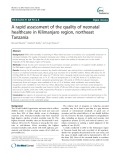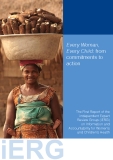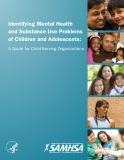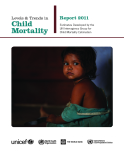
While child mortality
-
While child mortality is declining in Africa there has been no evidence of a comparable reduction in neonatal mortality. The quality of inpatient neonatal care is likely a contributing factor but data from resource limited settings are few.
 10p
10p  vivalanbo2711
vivalanbo2711
 19-03-2020
19-03-2020
 17
17
 5
5
 Download
Download
-
To provide basic services to the children as well as to the mothers for proper growth and development, the scheme of Integrated Child Development Services (ICDS) was initiated on 2nd October 1975. It was launched under the women and child development department to reduce the level of infant and child mortality rates. The grass root level workers who are called Anganwadi Workers (AWWs) provide the services of ICDS. The place where the services are provided is called Anganwadi.
 7p
7p  quenchua2
quenchua2
 18-12-2019
18-12-2019
 19
19
 0
0
 Download
Download
-
It is clear that with the current rate of progress India is likely to miss the MDG 4 (Goal 4) on child mortality. While the U5MR fell by about 41 per cent between 1990 and 2008, the IMR declined by 34 per cent during the corresponding period. This was mainly due to the fact that the NNMR, which contributes to two thirds of infant deaths, did not fall appreciably. The early neonatal mortality (within a week) which contributes to about 50 per cent of total infant deaths declined by only 27 per cent during the corresponding period.
 45p
45p  nhamnhiqa
nhamnhiqa
 01-03-2013
01-03-2013
 36
36
 1
1
 Download
Download
-
Nearly 90 percent of maternal deaths are concentrated in sub-Saharan Africa and South Asia. While South Asia has made steady progress, with a 53 percent drop in maternal mortality between 1990 and 2008, maternal deaths fell by 26 percent in sub-Saharan Africa during that time. About half of maternal deaths occur in six countries: Afghanistan, the Democratic Republic of the Congo (DRC), Ethiopia, India, Nigeria, and Pakistan. Targeted interventions in these countries could have a major impact on global maternal mortality.
 80p
80p  nhamnhiqa
nhamnhiqa
 01-03-2013
01-03-2013
 40
40
 3
3
 Download
Download
-
Responding to the disease burden of Communicable and Noncommunicable Diseases (NCD), the WCO will help strengthen the national capacity to reduce morbidity and mortality due to AIDS, tuberculosis and malaria, achieve high-level immunization coverage with all antigens in order to reduce the burden of vaccine-preventable diseases, achieve the eradication of polio, elimination/control of measles and neonatal tetanus, reduce morbidity due to helminthiasis, eliminate leprosy, intensify surveillance and response to epidemic-prone diseases, and reduce/control the burden of NCDs, while paying atten...
 70p
70p  nhamnhiqa
nhamnhiqa
 01-03-2013
01-03-2013
 57
57
 1
1
 Download
Download
-
Maternal mortality levels in Kenya remain unacceptably high at 488 per 100,000 live births 1 . The United Nations estimated in 2005 that 1 in every 39 Kenyan women die in childbirth; while major progress has been made in reducing infant and child mortality rates, one in every 19 babies born in Kenya this year will die before their first birthday. 60% of these deaths will occur in the neonatal period.
 138p
138p  nhamnhiqa
nhamnhiqa
 01-03-2013
01-03-2013
 45
45
 3
3
 Download
Download
-
We do the research that identifies causes of disease and disability. We advocate for solutions. We consult with policymakers and provide them with the evidence they need to make change. We roll our sleeves up and get to work in communities by influencing policies, identifying trends, implementing solutions, and increasing healthy behavior. Our work happens on a molecular level, and on a population-wide level. Microbiologists work to find a vaccine for malaria, while behavioral scientists research ways to discourage populations from smoking.
 222p
222p  nhamnhiqa
nhamnhiqa
 01-03-2013
01-03-2013
 45
45
 2
2
 Download
Download
-
For maternal mortality progress has been even more elusive. Despite 15 years of the Safe Motherhood Initiative, overall levels of maternal mortality are generally thought to have remained unchanged, with the latest estimate of deaths standing at approximately 530,000 per year (WHO, UNICEF et al. 2003). While a handful of countries have indeed experienced remarkable drops in maternal mortality ratio (an indicator of the safety of childbirth and pregnancy), in the great majority of high mortality countries, there has been little change.
 46p
46p  can_thai
can_thai
 12-12-2012
12-12-2012
 51
51
 3
3
 Download
Download
-
The first, most conventional way to characterize the global health picture is a description of health and disease. Today, the overall picture for child health and maternal health in poor countries is worrisome indeed. While child mortality has steadily declined in the last two decades, still approximately 10.8 million children under the age of five die each year. Progress on key indicators is slowing, and in parts of Sub-Saharan Africa, child mortality is on the rise. The great bulk of the mortality decline since the 1970s is attributable to reduction in deaths...
 79p
79p  can_thai
can_thai
 12-12-2012
12-12-2012
 61
61
 3
3
 Download
Download
-
New genomic technologies are changing the way we analyze diseases from one gene and one patient at a time, to population-wide analysis of entire genomes. These evolving tools are transforming how we do genetics and genomics, and have the potential to dramatically impact our understanding of a broad spectrum of diseases. While Canada has made significant investments in health genomics, the vast majority of these efforts have been focused on adult diseases.
 24p
24p  connhobinh
connhobinh
 10-12-2012
10-12-2012
 59
59
 1
1
 Download
Download
CHỦ ĐỀ BẠN MUỐN TÌM






















